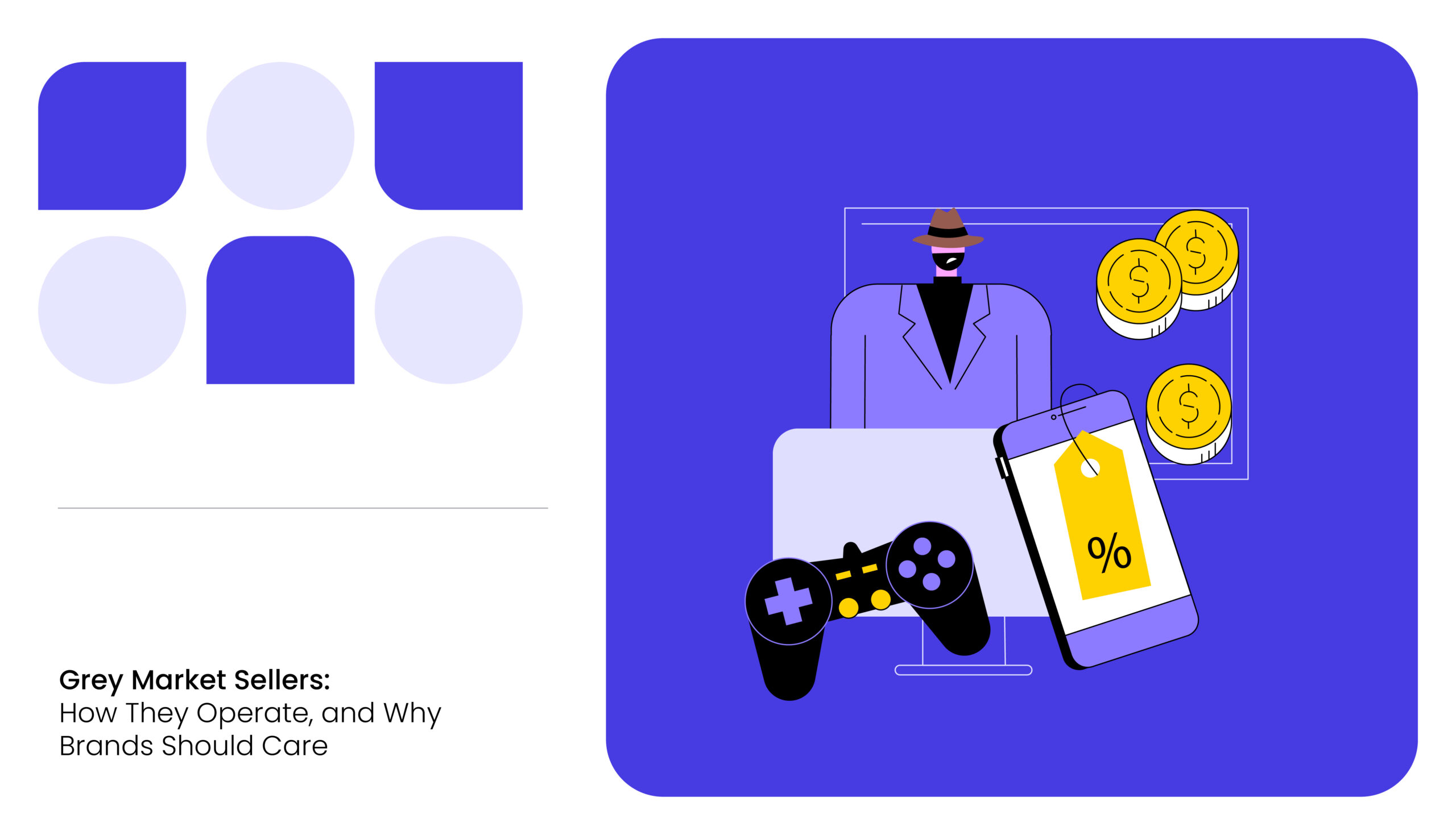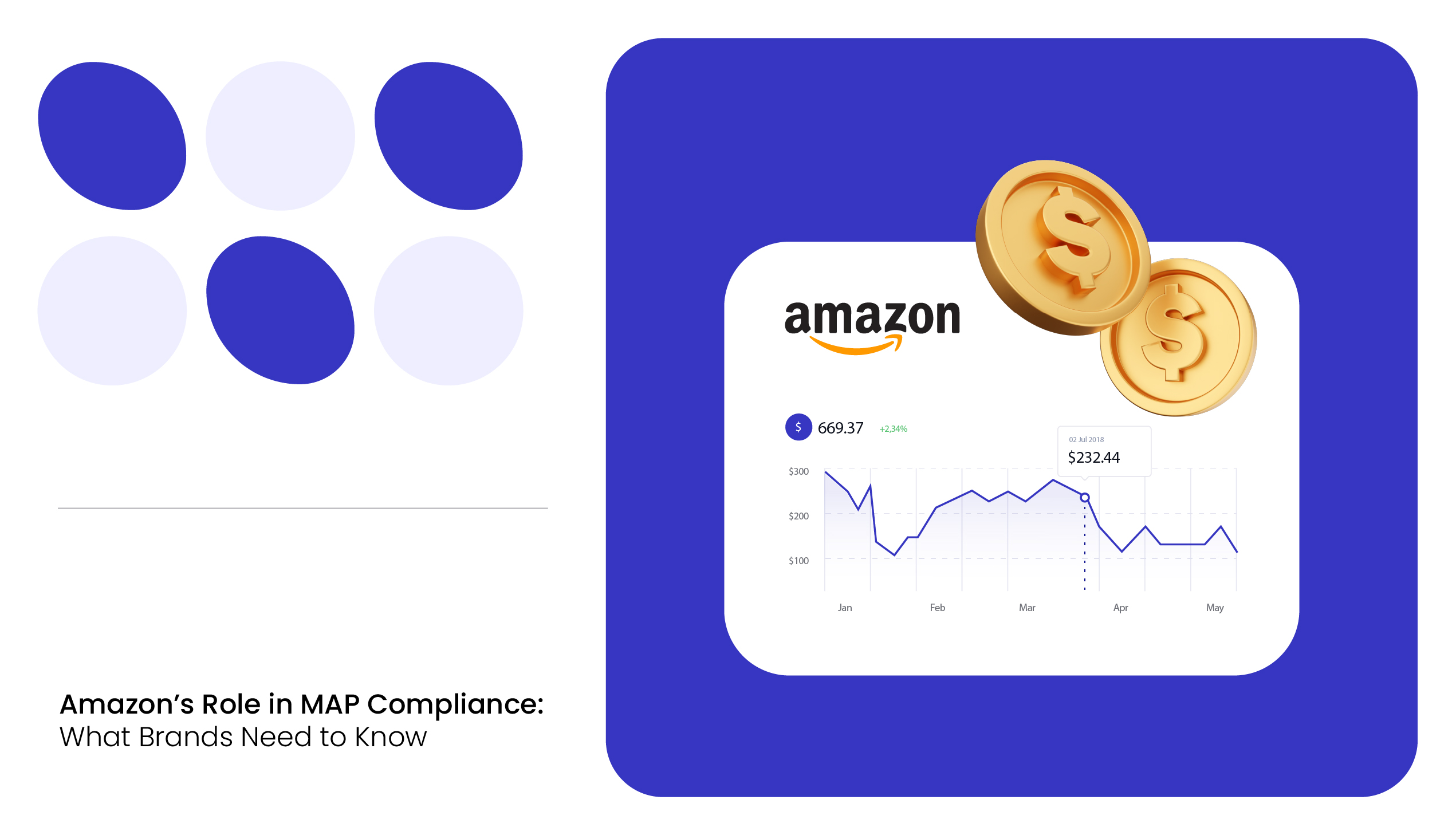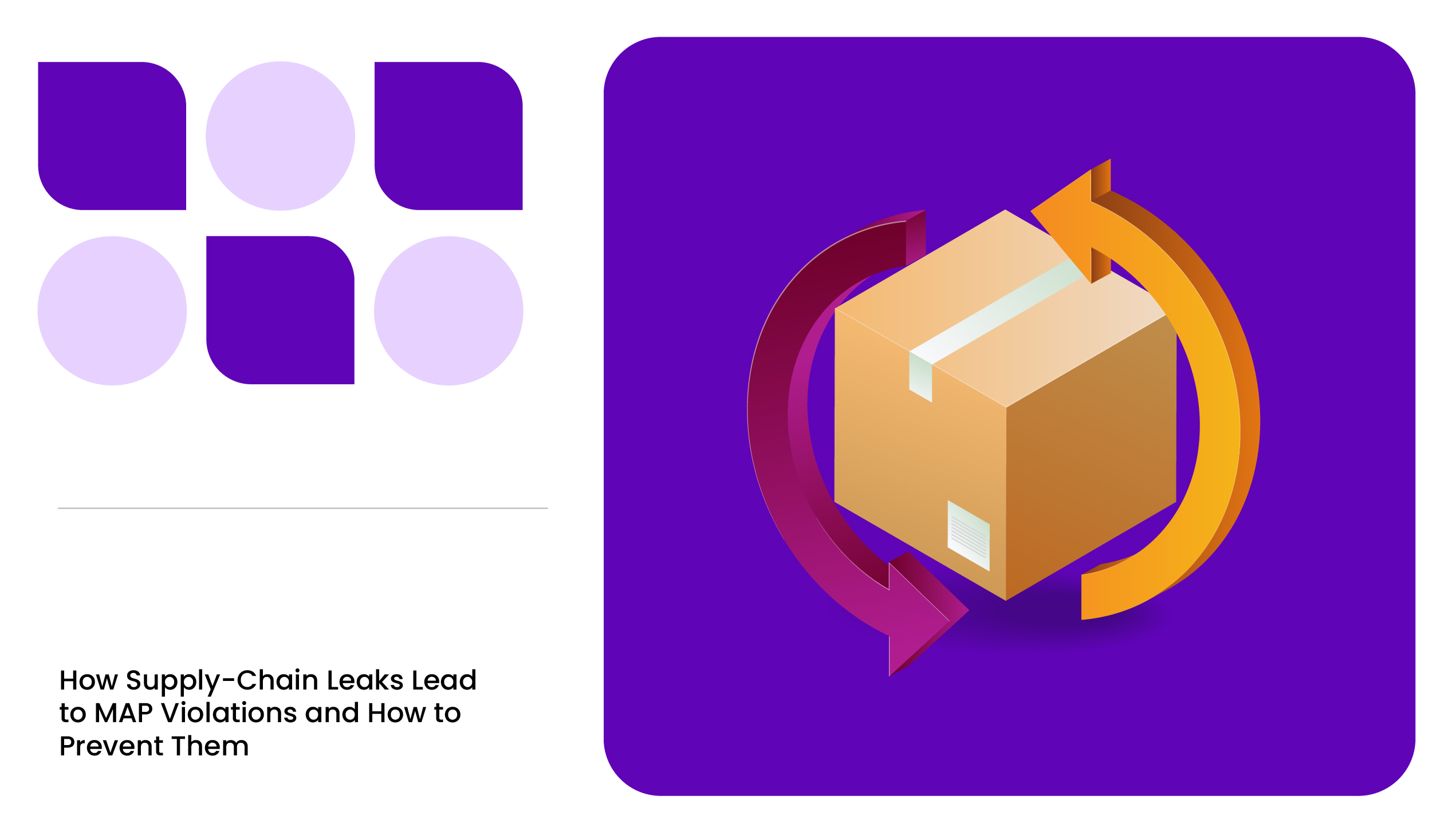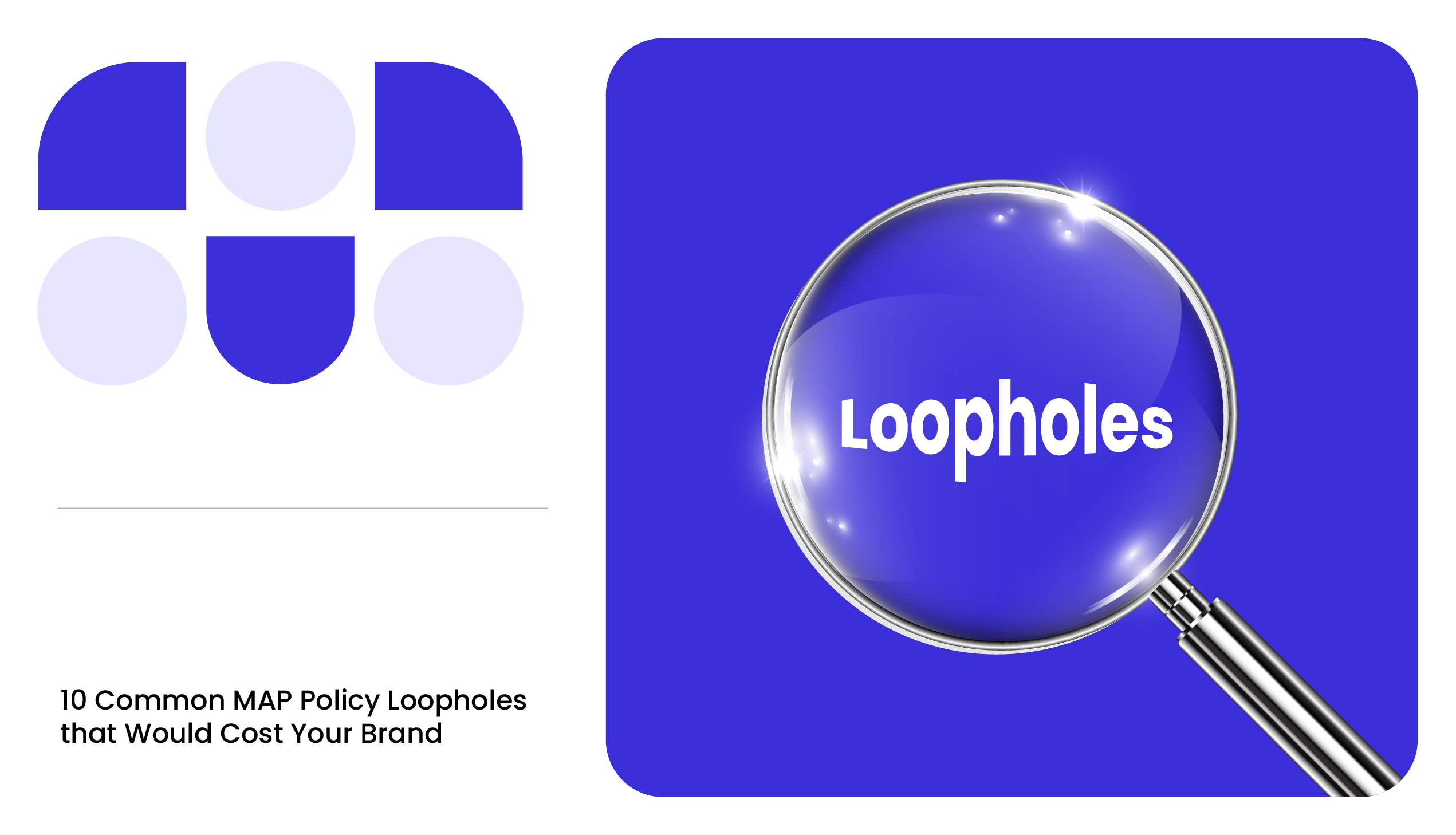On the digital shelf, you’re up against competitors, algorithms, and invisible threats that quietly erode your brand value.
One of the biggest culprits? Grey market sellers. They aren’t selling knock-offs or stolen goods, but they’re not doing your brand any favors either. These gray market sellers operate outside your authorized distribution channels and undercut your prices, often without breaking a single law.
The result? Your pricing strategy gets blown to bits, your partners get frustrated, and your customers are left confused.
In this blog, we’ll break down who grey market sellers are, how they operate, how they affect your brand, and what you can actually do about them. If you’re responsible for protecting your brand online, this one’s for you.
What Is the Grey Market?
The grey market refers to the sale of genuine, brand-name products through unauthorized channels. These aren’t fake goods, they’re real products sold in a way the brand didn’t intend.
Think of a luxury watch purchased overseas at a discount and then resold online in another country, bypassing the brand’s pricing and distribution controls.
So, how is this different from the black market? Easy. The black market deals in illegal goods. Grey market operations involve the sale of legal goods in unauthorized ways, operating in the gray area of rules and regulations. This distinction makes grey market sellers difficult to regulate, but no less dangerous to your brand’s positioning.
Grey market sellers’ operations are widespread in high-demand categories, such as electronics, luxury items, cosmetics, and consumer packaged goods (CPG), where price gaps between geographies or channels are large enough to generate a profit.
How Grey Market Sellers Operate?
Let’s examine the inner workings of grey market operations step by step so you can understand what you’re really up against.
Sourcing: Where the Goods Come From
Grey market sellers are opportunists. They source inventory from:
- Liquidation channels: Products sold off in bulk at a steep discount due to overstock, end-of-season, or distressed sales.
- Cross-border arbitrage: Buying goods in countries where prices are lower due to exchange rates, taxes, or local MSRP, and selling in higher-priced markets.
- Distributor leakage: When an authorized partner resells to a third party who isn’t on your approved list, either knowingly or unknowingly.
This is where shadow hierarchies come into play. Legitimate distributors sometimes, through poor oversight, feed grey market supply chains. It creates invisible networks of unauthorized resellers who appear legitimate to unsuspecting buyers.
READ MORE| Tired of unauthorized sellers eroding your pricing integrity? Learn How to Stop Unauthorized Sellers on Amazon.
Selling: How They List and Compete
Once they have the goods, gray market sellers go live fast. They list products on Amazon, Walmart, eBay, and other third-party marketplaces. Their primary tactic is simple: undercut the price and dominate the Buy Box.
No warranty. No brand story. And no data back to the brand. Why? Because, for grey market operations, the game is all about pricing.
By cutting corners on service, support, and brand experience, they focus solely on price competitiveness. That’s dangerous in a world where online brand reputation and customer loyalty hinge on value and trust.
Shadow Hierarchies and Distribution Leakage
The scary part? A lot of grey listings stem from your own network. Maybe it’s a wholesaler unloading excess stock. Maybe it’s a distributor who doesn’t monitor their downstream buyers. These shadow hierarchies are almost impossible to detect manually.
With tools like MetricsCart’s MAP Monitoring, protect your brand online with unauthorized reseller price tracking, instant MAP violation detection, and take action before damage is done.

Risks for Brands: What’s at Stake
Grey market operations don’t just eat into revenue; they weaken the entire brand ecosystem. When unauthorized sellers take over your listings, your official partners lose trust, and your brand loses consistency across touchpoints. Let’s break down the key risks:
Price Erosion and Channel Conflict
MAP violations lead to price wars and price erosion, which frustrate your authorized retailers and partners. Your resellers may stop stocking or promoting your products altogether, knowing they can’t compete with grey market pricing.
This price instability also breeds channel conflict. Your brand could be competing with itself; your authorized sellers against unauthorized ones. It ultimately creates confusion for your customers and diminishes the perceived value of your product.
Over time, this can erode your brand’s ability to set and maintain pricing policies that reflect its actual market value.
Brand Dilution and Customer Confusion
Buyers on Amazon or Walmart don’t know the difference between authorized and unauthorized sellers. So, when a customer purchases your product from a gray market seller and receives poor service, whether it’s missing warranty coverage or zero post-purchase support, the complaint falls squarely on your brand’s shoulders.
This leads to brand dilution and customer confusion. Over time, customers associate your brand with a negative experience, as grey market sellers often fail to meet the same quality standards or provide the same level of customer care.
Loss of Data and Visibility
Every sale that bypasses your authorized channels means lost customer data, missed insights, and zero post-purchase engagement. That weakens your digital shelf strategy and limits your ability to optimize product listings, content, and review management.
Additionally, by not having direct visibility into who is buying and selling your products, you’re also missing out on the opportunity to manage post-purchase engagement effectively. Without this crucial touchpoint, your brand’s ability to drive repeat business and optimize product listings and content diminishes, reducing your overall e-commerce performance.
How To Detect Grey Market Activity?
Grey market activity can sneak up on you if you’re not paying close attention. Detecting it early is key to minimizing damage to your brand and pricing strategy.
Here’s what to watch for to catch grey market sellers before they hurt your bottom line:
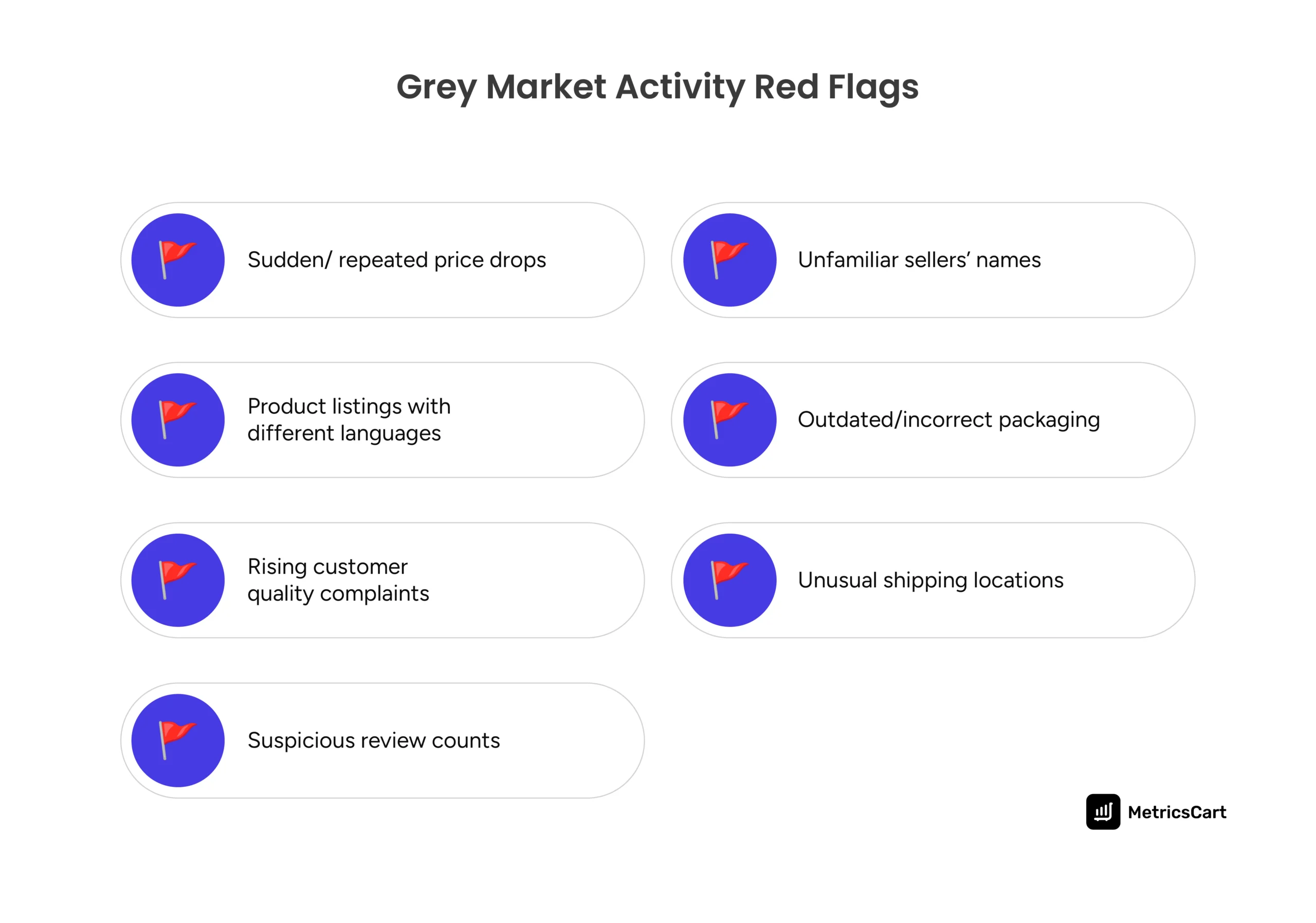
- Sudden or repeated price drops below your MAP threshold: If you notice prices dropping significantly, especially from new sellers or outside your authorized channels, it’s a red flag.
- Seller names that aren’t on your authorized list: New or unfamiliar sellers popping up on platforms like Amazon or eBay, particularly with your products, are often an indication of grey market sellers’ operation.
- Product listings with different languages, outdated packaging, or missing documentation: If you see variations in packaging, product descriptions, or language discrepancies, it could signal that the products were sourced from outside your designated regions or distribution channels.
- Increased customer complaints about warranty, product quality, or support: Grey market products often lack the same support or warranty coverage, which leads to more complaints or negative reviews. If customers are regularly reporting issues with your product, even if it’s the same SKU, it’s worth investigating further.
- Unusual shipping locations or delivery times: If orders are being fulfilled from regions that aren’t part of your approved supply chain, or delivery times are inconsistent with your expected standards, it could signal grey market operations.
- Unverified reviews or suspiciously high review counts: If you notice sellers with a higher-than-normal volume of reviews or mostly generic, low-quality feedback, it might indicate a grey market listing, as these sellers typically have less authentic engagement.
MetricsCart’s MAP monitoring dashboard automates unauthorized reseller price monitoring for real-time alerts on when a new or unknown seller pops up, the price drops, or a MAP violation occurs, helping you spot grey market activity before it takes a toll on your brand.
How Can Brands Tackle Grey Market Operations?
When it comes to combating grey market activity, proactive measures are key. Here are some practical steps to regain control and safeguard your brand:
Strengthen Channel Controls
Audit your supply chain. Tighten distributor agreements. Utilize serial tracking to monitor the movement of your products. If you’re not watching your own network, someone else is exploiting it.
Use MAP Monitoring Tools
Active tracking is a must-have. Choosing MAP Monitoring software gives you a real-time view of who’s selling what, where, and at what price. This enables you to respond to threats quickly and maintain your pricing integrity.
Legal and Platform Enforcement
Don’t hesitate to send cease-and-desist letters or file IP claims with Amazon Brand Registry or Walmart’s enforcement teams. You have the right to control your distribution.
Partner Education
Help your partners understand the cost of grey market leakage. Provide them with guidelines, tools, and incentives to stay compliant. Make it easy for them to report unauthorized listings.
Final Notes
Grey market sellers aren’t just undercutting your price; they’re chipping away at your brand’s reputation, customer trust, and long-term profitability.
While you can’t eliminate the grey market entirely, with the right tools and strategies, you can regain control of your digital shelf and protect your brand’s integrity. By tightening distribution controls, using MAP monitoring, and enforcement policies, you can stay ahead of unauthorized sellers and maintain a strong, consistent brand presence across all platforms.
Don’t let grey market operations erode your brand’s value. Book a demo with MetricsCart today and discover how MAP monitoring and pricing intelligence tools can help you take control of your brand’s destiny, before it’s too late.
Grey Market Killing Your Margins? Protect Your Brand with MetricsCart!
FAQs
It’s when authentic products are sold through unauthorized channels, often across borders or outside agreed pricing terms.
You might not get a valid warranty, support, or return policy. It also increases your chances of buying expired or mishandled goods.
No, it’s not illegal. But it’s usually against a brand’s distribution policies.
Sellers exploit price gaps and supply chain loopholes to resell authentic products at a margin, causing severe damage to the brand ecosystem and online reputation.
For brands, grey market operations mean lost control, price erosion, poor customer experience, and no data visibility.

